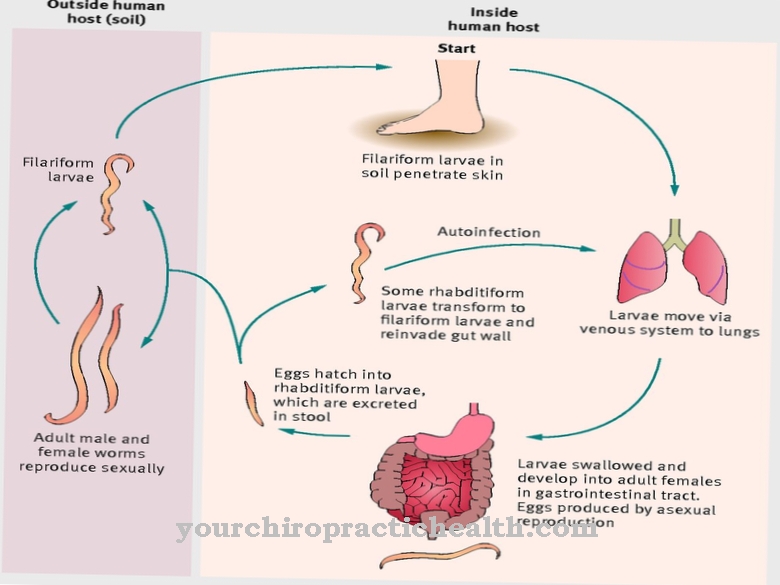Enteroviruses are non-enveloped, icosahedral viruses whose genetic material is in the form of RNA. Therefore they belong to the RNA viruses. They multiply in the cell plasma of the infected host cell. As pathogens in humans, they can lead to many non-specific symptoms, in particular to gastrointestinal complaints and flu-like infections. The increased occurrence of summer flu on hot days is often due to enteroviruses. Apart from that, however, they are also responsible for common diseases such as polio (polio) and hepatitis A.
What are enteroviruses?
Enteroviruses are a genus of viruses to which a total of 9 species with many different subtypes are counted. These are single-stranded RNA viruses, also known as pico-RNA viruses. Enteroviruses have an icosahedral shape and are about 25 nm in size on average. You are not covered.
The genetic information of these viruses is in the form of RNA as a single strand with positive polarization. Due to the positive polarization, the RNA of the virus can be translated directly into protein as it multiplies in the host cell. In contrast, viruses containing DNA must first convert their genetic material into RNA.
Occurrence, Distribution & Properties
Enteroviruses are not only found in humans, but also in pigs, rodents, cattle and various species of monkeys. On the other hand, there is no geographical restriction of the distribution area, the enteroviruses occur worldwide. However, some of the diseases caused by them are much more common in developing countries, because the necessary preventive measures, such as nationwide vaccination or certain hygienic standards, cannot be adequately implemented there. Enteroviruses are acid stable.
As a rule, a distinction is made between the following types of enteroviruses that are important for humans: polioviruses, hepatitis A viruses, Coxsackie viruses, echoviruses and human enteroviruses 68-71 and 73.
The possible transmission routes are droplet and smear infection, with faecal-oral infection (smear infection) being much more common. It can take place, for example, through food or drinking water contaminated with stool or saliva, toys and hands. Swimming pools or lakes contaminated with faeces are also a significant source of infection. Therefore, infections with enteroviruses occur particularly frequently in the temperate climate zone in summer.
If a pregnant woman becomes infected with enteroviruses, she can also infect the child via the placenta, which can have serious consequences, including pneumonia in the infant.
The incubation time for an infection with enteroviruses can be two to 35 days, but is usually between five and seven days on average. Enteroviruses multiply in the patient's intestinal wall and mesenteric lymph nodes after infection. From there they can enter the patient's bloodstream; temporary viraemia can occur. Almost any organ in the body can then be infested. Therefore there can be many different symptoms that alone are not sufficient for a clear clinical diagnosis. The detection usually takes place via virus cultivation in cell culture or genetic methods such as qr-RT-PCR.
Illnesses & ailments
There is no fixed link between a type of enterovirus and a specific clinical picture. The symptoms are often non-specific and overlap between the various enteroviruses as well as other pathogens. However, some enteroviruses are detected particularly frequently in certain clinical pictures, so that they are considered typical. The most common unspecific symptoms include gastrointestinal complaints.
Polioviruses, which mainly affect children, cause flu-like infections or aseptic meningitis (inflammation of the brain), possibly affecting the central nervous system. The most well-known consequence of an infection with poliovirus is probably polio. Symptoms of polio include fever, fatigue, headache, nausea, body aches, and stiff neck. However, permanent paralysis only occurs in some of the infected. The most effective protection against the disease is vaccination. A cure from polio is not possible. Today polio is no longer common in most countries due to the good vaccination status of the population.
Coxsackie viruses are also the trigger for flu-like infections, but also lead to infections of the respiratory tract or the heart muscle, as well as hand, foot and mouth disease and Bornholm disease. Newborns and children are particularly at risk from the Coxsackie virus.
Echoviruses manifest themselves in unspecific febrile illnesses and respiratory infections. Symptoms include diarrhea. Echoviruses are particularly often detected in aseptic meningitis and inflammation of the pericardium or the heart muscle.
The hepatitis A virus is also known as Enterovirus 72 and is the causative agent of hepatitis A. After it is spread through the blood of the infected person, the liver becomes infected, which leads to inflammation (hepatitis).
The so-called human enteroviruses 68-71 and 73 usually cause acute respiratory infections. Sometimes polio-like symptoms also occur.
Most infections with enteroviruses, up to 90-95%, remain completely symptom-free and are therefore often not noticed at all. The treatment of an infection with enteroviruses is symptomatic and depends heavily on which organ system is affected. A drug therapy of the causes is so far not possible. After an infection with enteroviruses, the body has a permanent serotype-specific immunity against the type of virus with which the infection occurred.

















.jpg)



.jpg)

.jpg)




